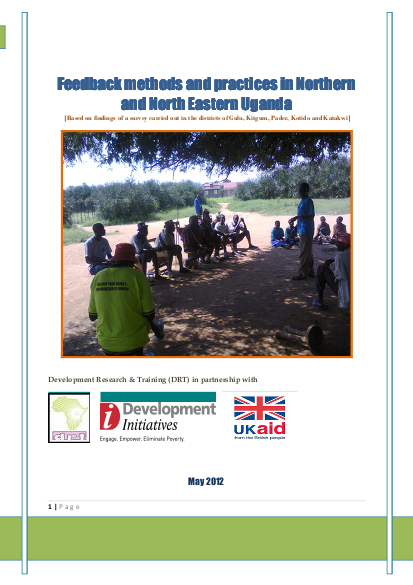
The report identifies the existing opportunities for the communities to give information about their humanitarian and development needs and the responsiveness of various resources flows. It also assesses the extent to which various methods use beneficiary feedback on the quantity, quality and relevance of was used to improve the policy, programming and planning for subsequent programmes/projects for better humanitarian and development response. The entire chain of gathering, sorting, synthesizing and use of beneficiary feedback to improve development programmes for better outcomes in poverty and vulnerability reduction. The survey covered a sample of organizations and hence does not represent an exhaustive representation of all existing feedback mechanisms currently used or developed by all the stakeholders in the northern region. The report summarizes literature reviewed at both the district and national level; interviews with government officials at the district and lower governments and staff of non-government organizations. Information about existing methods and practices was also collected from citizens at the communities in the above mentioned districts.
There has been growing concern to improve the effectiveness of humanitarian and development resources through improved transparency and accountability both to donors and to affected communities. The main objective of the survey was to identify the existing opportunities to access information on resource flows and in turn feedback into policy-making and development processes. The extent to which evidence on the is utilized to improve design, delivery and information management systems for better reduction and humanitarian outcomes. The survey covered 5 districts of Gulu, Pader, Kitgum, Kotido and Katakwi in the Acholi, Karamoja and Teso sub regions of northern and eastern Uganda. Interviews were held with officials at established government structures at three levels at which decisions are made on resource allocation for service delivery. The survey assessed how beneficiary feed back from affected communities on the quality and relevance of resources to their community in meeting their humanitarian and development needs. The assessment looked at how information and feedback is gathered, sorted, synthesized and used to inform decision making in government and non-government efforts to reduce poverty and promote development. The report also uses information from literature reviewed and discussions with key informants at the national, district and community levels with officials from government, international humanitarian and development agencies and civil society. At the district and sub-county, the team interacted not only with the district local government officials in specific departments which are tasked with the role of planning and decision making but also the political leaders who play the legislative function at the various levels. For the beneficiaries at the village level, group discussions were held to ascertain their awareness of government and non government interventions but also their views and perceptions on the relevance, responsiveness and quality of available services to the peoples’ needs.